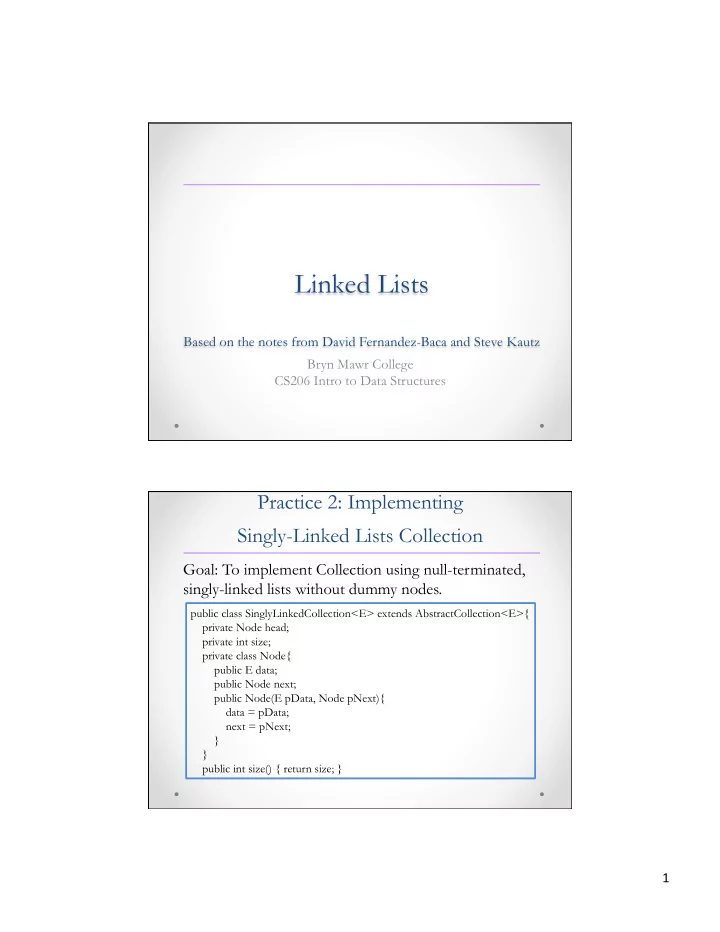

Linked Lists Based on the notes from David Fernandez-Baca and Steve Kautz Bryn Mawr College CS206 Intro to Data Structures Practice 2: Implementing Singly-Linked Lists Collection Goal: To implement Collection using null-terminated, singly-linked lists without dummy nodes. public class SinglyLinkedCollection<E> extends AbstractCollection<E>{ private Node head; private int size; private class Node{ public E data; public Node next; public Node(E pData, Node pNext){ data = pData; next = pNext; } } public int size() { return size; } 1 ¡
add() public boolean add(E item) { //add an item at the end Node temp = new Node(item, null); if (head == null) { // add to empty list head = temp; } else { // add after tail Node current = head; while (current.next != null) { current = current.next; } current.next = temp; } ++size; return true; } First attempt: remove() public boolean remove(Object obj) { Node current = head; Node previous = null; while (current != null) { // TODO: if current.data matches obj, // unlink current and return true // (don’t forget special case for head) previous = current; current = current.next; } return false; } To remove an element in a singly linked list, we need a reference to the predecessor of the node to be removed. More later… 2 ¡
Iterators The state of an iterator is represented by three variables: • cursor: Points to the predecessor of the next element. The value of cursor is null if the next element is head, or if the list is empty. • canRemove: A Boolean variable that indicates whether it is legal to invoke remove(). • previous: Points to the predecessor of the node to be removed. More precisely: o If canRemove is true and cursor != head, then previous points to the predecessor of cursor. o If cursor == head, then previous == null. o If canRemove is false, then previous == null. Iterators (cont.) public Iterator<E> iterator() { return new LinkedIterator(); } private class LinkedIterator implements Iterator<E> { private Node cursor = null; private Node previous = null; private boolean canRemove = false; public boolean hasNext() { return size > 0 && (cursor == null || cursor.next != null); } public E next() { if (!hasNext()) throw new NoSuchElementException(); // we know size > 0 and either cursor is null //or cursor.next is non-null if (cursor == null) { // next element to return is head previous = null; cursor = head; } else { previous = cursor; cursor = cursor.next; } canRemove = true; return cursor.data; } 3 ¡
Iterators (cont.) public void remove() { if (!canRemove) throw new IllegalStateException(); if (previous == null) { // removing first element head = head.next; cursor = null; } else { // removing element at cursor previous.next = cursor.next; cursor = previous; } --size; canRemove = false; previous = null; } } } Time Complexity • Getting an element at a given index o Linked list:O(n) - Reason: We have to traverse the list to find the position o Array list:O(1) • Checking contains(object) o Linked list:O(n) o Array list:O(n) • Checking size() o Linked list:O(1) o Array list:O(1) 4 ¡
Time Complexity (cont.) • Adding a new element at the end o Linked list:O(1) o Array list: O(1): during a sequence of such operations, we may have to resize the array several times. In practice we don ʼ t worry about this, because we can claim that adding n elements to an array list requires time O(n). That is, the amortized cost per add is O(1). Explanation (Optional): Suppose we start out at size 1 and that n is a multiple of 2,say n is 2 p . Each time we run out of space, we double the capacity. Then, there are resize operations for sizes 1, 2, 4, 8, 16, ..., 2 p-1 . A resize operation on an array of size k takes time O(k). So the total cost of all the resize operations is O(1 + 2 + 4 + ... + 2 p-1 ) = O(2 p ) = O(n). Time Complexity (cont.) • Adding or removing at a given position o Linked list: O(n) – we have to traverse the list to find the position o Array list: O(n) – we have to shift elements to add/ remove in the middle of the array • Removing a given element o Linked list: O(n) – we have to find the element o Array list: O(n) – we have to find the element, then shift elements to remove, but O(n) + O(n) = O(n) 5 ¡
Time Complexity (cont.) • Adding or removing an element during iteration o Linked list: O(1) – Already have the node, so linking or unlinking is O(1) o Array list: O(n) – We have to shift elements to add/ remove • Given a list of length n, iterate over the list and perform k adds or removes at arbitrary locations: o Linked list: O(n) + O(k) = O(n + k) or O(max(n, k)) o Array list: O(nk) – each of the k operations is potentially O(n) Space Complexity • Array lists potentially waste some space because of the empty cells. (But remember, each empty cell is just an object reference – it takes up 4 bytes, not the space of the object itself!) • For many short lists, linked lists may be more space- efficient. On the other hand, linked lists potentially waste space, because each element has to be wrapped in its own node object. 6 ¡
Recommend
More recommend